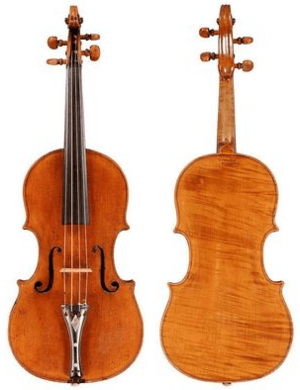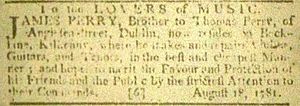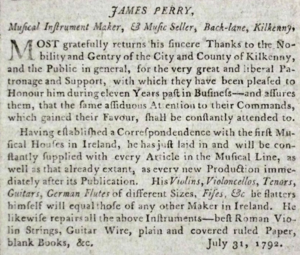James Perry (luthier) facts for kids
Quick facts for kids
James Perry
|
|
|---|---|
| Séamus de Poire | |

Violin by Perry, c. 1800
|
|
| Born | c. 1759 Dublin, Ireland
|
| Died | c. 1810 Kilkenny, Ireland
|
| Nationality | Irish |
| Education | Thomas Perry |
| Known for | Luthier |
| Style |
|
| Movement | Irish school |
| Patron(s) | Ormonde family |
James Perry (whose name in Irish was Séamus de Poire) was a famous Irish luthier. A luthier is someone who makes or repairs stringed instruments like violins. James Perry lived from about 1759 to 1810. He was known for making amazing violins, violas, and cellos.
His workshop was in Kilkenny, Ireland. He also made other instruments like guitars, German flutes, fifes, and tenors. People believe James Perry made over 1,000 instruments in his lifetime! He learned his craft from his older brother, Thomas Perry, who was also a luthier in Dublin. James was also supported by the powerful Ormonde family from Kilkenny Castle.
Contents
Early Life and Family
James Perry was born in Dublin around 1759. His father, John Perry, was a musical instrument maker and a landowner. James grew up in a family of talented instrument makers. He had at least two older brothers, Thomas and John, who also became successful luthiers.
His oldest brother, Thomas, was born around 1738. Thomas started his own workshop in Dublin around the same time James was born. He became one of Ireland's most productive luthiers. Another brother, John, born around 1747, also became a well-known maker in Belfast. James also had a cousin, Joseph Perry, who was a respected luthier in Dublin.
James was likely the youngest in his family, almost 20 years younger than his brother Thomas. He grew up surrounded by instrument making. His father and two older brothers were already skilled makers by the time James was 10. It's very likely that James spent a lot of time in the workshop. This helped him develop a love for making instruments at a young age. The area where James grew up in Dublin, near Christ Church, was famous for violin making in the 1700s. Many great makers worked there.
Career as an Instrument Maker
Learning the Craft: 1773–1781
James Perry became an apprentice to his brother Thomas in Dublin. An apprentice is someone who learns a skill or trade from a master. James trained with Thomas from 1773 to 1780. By this time, Thomas had been working on his own for nearly 15 years and was a very skilled maker. During his apprenticeship, James learned how to be a luthier. He picked up many of the special techniques used by the Perry family workshop. Throughout his career, James's instruments looked a lot like his brother's early work.
After his training in Dublin, James moved to Kilkenny in 1781. He opened his own shop on a street called Back Lane (which is now Saint Kieran's Street). He might have moved to Kilkenny to avoid competing with his more famous brother, Thomas. On August 18, 1781, James put an advertisement in a newspaper called Finn's Leinster Journal. He wanted to let people know about his new business.
The advertisement said:
To the LOVERS of MUSIC.
JAMES PERRY, Brother to Thomas Perry, of Anglesea-street, Dublin, now resides in Back-lane, Kilkenny, where he makes and repairs Violins, Guitars, and Tenors, in the best and cheapest Manner ; and hopes to merit the Favour and Protection of his Friends and the Public by the strictest Attention to their Commands.
August 18, 1781.
Support and Later Years: 1781–1810
James Perry's business quickly gained support from the Ormonde family of Kilkenny Castle. This kind of support from important people is called "patronage." Other wealthy families and important people in Kilkenny also supported him. James became known as a general musical instrument maker. He made and repaired many instruments, including violins, violas, cellos, guitars, German flutes, fifes, and tenors.
Perry's shop also sold sheet music, which included both old and new songs. In 1788, James was listed in the Dublin Directories as a maker of violins, cellos, and guitars at 4 Trinity Street in Dublin. This suggests he might have traveled back to Dublin often to visit his family and work there. On July 31, 1792, Perry placed another advertisement in Finn's Leinster Journal. This time, he thanked his supporters and the public. He also promised to continue providing great service. The ad also listed all the different services his shop offered.
The advertisement read:
JAMES PERRY,
Musical Instrument Maker, & Music Seller, Back-lane, Kilkenny,
MOST gratefully returns his sincere Thanks to the Nobility and Gentry of the City and County of Kilkenny, and the Public in general, for the very great and liberal Patronage and Support, with which they have been pleased to Honour him during eleven Years passed in Business—and assures them, that the same assiduous Attention to their Commands, which gained their Favour, shall be constantly attended to.
Having established a Correspondendence with the first Musical Houses in Ireland, he has just laid in and will be constantly supplied with every Article in the Musical Line, as well as that already extant, as every new Production immediately after its Publication. His Violins, Violoncellos, Tenors, Guitars, German Flutes of different Sizes, Fifes, &c he flatters himself will equal those of any other Maker in Ireland. He likewise repairs all the above Instruments—best Roman Violin Strings, Guitar Wire, plain and covered ruled Paper, blank books, &c.
July 31, 1792.
In 1797, an Italian luthier named Vincenzo Panormo came to Ireland. He worked in Cork for three years. In 1799, Panormo moved to Dublin to work for James's brother, Thomas. However, a cello found with a label saying "Vincenzo Panormo/fecit Kilkenny/Irelande, 1799" suggests that Panormo also worked in Kilkenny for a short time. It's very likely that Panormo made this cello in James Perry's workshop. By this time, James's workshop was in a part of Kilkenny called Red Lane. He lived in a different building on Velvet Lane, near St Canice's Cathedral.
We don't know exactly when James Perry stopped making instruments or when he died. The latest instrument found that he made is from 1810. This suggests he either stopped working or passed away around that time.
Perry's Instrument Style
James Perry's way of making violins was very typical of the early Irish style. This style was greatly influenced by the Stainer model, a famous way of making violins. His violins looked very similar to his brother Thomas's early instruments.
Perry used a dark brown varnish on his older instruments and a more golden brown varnish on his newer ones. His brother Thomas did the same. The f-holes (the S-shaped openings on the front of the instrument) on his instruments had a special, slightly exaggerated look. This was also similar to instruments made by his brother Thomas. Perry often branded his instruments on the back, below the button, with "JAMES PERRY/KILKENNY" or "J PERRY/KILKENNY." This was a common mark of the Irish school of instrument making.
Some people thought James Perry's craftsmanship was a bit rougher than his brother Thomas's. However, his instruments were known for having an excellent and wonderfully sweet sound. This sweet tone was especially popular with Irish traditional musicians. Some even preferred his instruments over those made by his brother Thomas! Notes from the Kilkenny Archaeological Society in 1953 described him as a "violin maker of great repute." They also said that his violins were "still used and cherished by Kilkenny folk."
|
|||||||||||||||||||||||||||||||||||||||||||||||||||||||||||||||||||||||||||||||||||||||||||||||||||||||||||||||||||||||||||||||||||||||||||||||||||||||||||||||||||||||||||||||||||||||||||||||||||||||||||||||||||||||||||||||||||||||||||||||||||||||||||||||||||||||||||||||||||||||||||||||||||||||||||||||||||||||||||||||||||||||||||||||||||||||||||||||||||||||||||||||||||||||||||||||||||||||||||||||||||||||||||||||||||||||||||||||||||||||||||||||||||||||||||||||||||||||||||||||||||||||||||||||||||||||||||||||||||
|
|||||||||||||||||||||||||||||||||||||||||||||||||||||||||||||||||||||||||||||||||||||||||||||||||||||||||||||||||||||||||||||||||||||||||||||||||||||||||||||||||||||||||||||||||||||||||||||||||||||||||||||||||||||||||||||||||||||||||||||||||||||||||||||||||||||||||||||||||||||||||||||||||||||||||||||||||||||||||||||||||||||||||||||||||||||||||||||||||||||||||||||||||||||||||||||||||||||||||||||||||||||||||||||||||||||||||||||||||||||||||||||||||||||||||||||||||||||||||||||||||||||||||||||||||||||||||||||||||||
Instruments Still Around Today
It's not known exactly how many instruments James Perry made. Some people say he made about 300 stringed instruments. However, some of his surviving instruments have numbers higher than 1,000! It's likely that Perry numbered all the instruments made in his workshop, including smaller ones like flutes and fifes. He probably learned this numbering system from his brother Thomas, who also made a huge number of instruments in the same way.
Here are some examples of instruments made by James Perry that still exist:
- Violins:
* One of his earliest known violins is from 1776. He made it while working for his brother Thomas in Dublin. * A violin from 1783 (number 129) is now in Australia. It was brought there from London in 1857. * A violin from 1799 (number 1020) has a one-piece front and back, with a golden brown varnish. * His latest identified violin is from 1810 (number 1417).
- Violas:
* One of the few violas identified as made by Perry is from 1786. It was sold at an auction in 1990.
- Viola d'amores:
* A rare viola d'amore from 1769 is one of his earliest instruments. The date might mean he was making instruments even before his official apprenticeship.
- Cellos:
* One of the few cellos identified as made by Perry is from around 1790. It is branded "PERRY/KILKENNY" on the back.
See also
- Thomas Perry (luthier)
- Vincenzo Panormo
- Richard Tobin



